Australia Middle East Journalism Exchange Assignment, Deakin University
Walking through the famed Marrakech Medina in Morocco, henna parlours aren’t an uncommon sight. Henna has almost become a rite of passage for tourists abroad in Asian, Middle Eastern and North African (MENA) regions. Although the tourist industry may happily embrace henna popularity from foreigners, many who wander into henna parlours aren’t aware of the meaning and history behind the ancient art. Henna is one of the few things that the traditional peoples of Morocco, the Amazigh, are able to keep their history alive with.
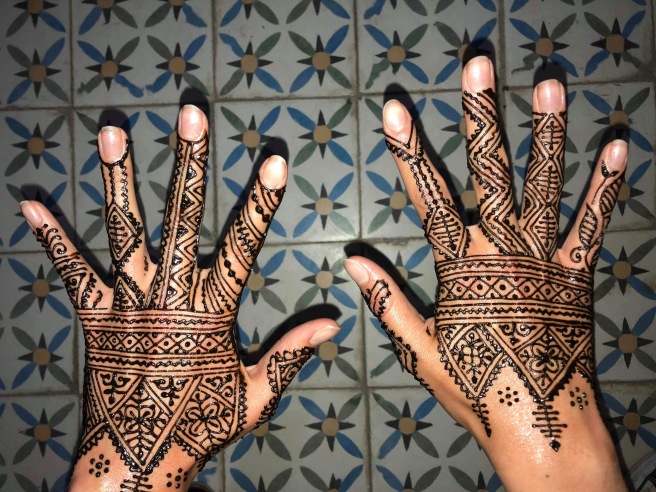 Although the date is debated, many believe henna has been practiced for over 5000-9000 years in the MENA region, Pakistan and India.
Although the date is debated, many believe henna has been practiced for over 5000-9000 years in the MENA region, Pakistan and India.
Amazigh believe that henna brings good luck and protection from the evil eye. For these reasons, many of the designs include shapes such as diamonds, the hamsa or the eye.
Henna is used for many Amazigh celebrations such as weddings and festivals. It also has a practical element to cool down the hands and soles of feet in the hot climate of Morocco.
Henna paste used to paint the skin is made from the Lawsonia Inermis hinna plant. The leaves from the hinna plant are dried and crushed into a powder. The powder then has to be mixed with something acidic like rainwater, coffee, lemon, certain oils or tea to make a good stain.
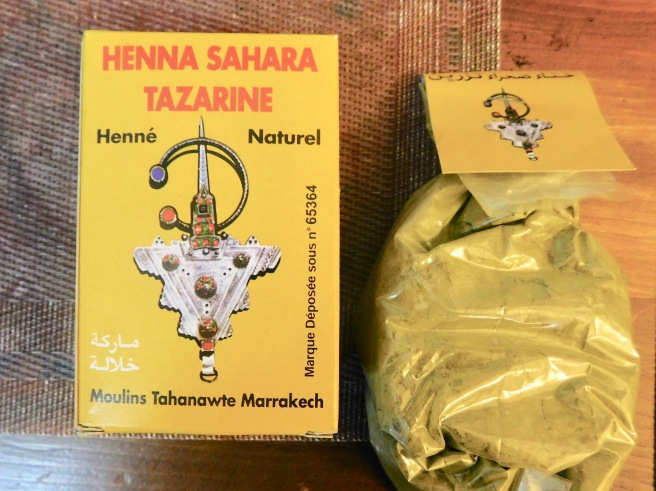 Henna powder, pictured above, is produced in Morocco from the native hinna plant.
Henna powder, pictured above, is produced in Morocco from the native hinna plant.
There are different styles of henna in Morocco. Various styles range from Saharan designs, Fesi designs and Marrakech designs. These designs can incorporate linear, star, triangle, floral and other geometric shapes.
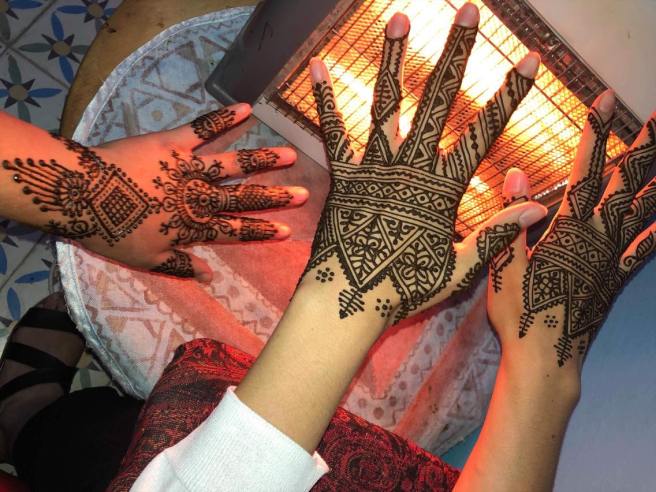 The above photo depicts linear designs from the Saharan region, geometric shapes from Marrakech and floral designs from the Fesi region.
The above photo depicts linear designs from the Saharan region, geometric shapes from Marrakech and floral designs from the Fesi region.
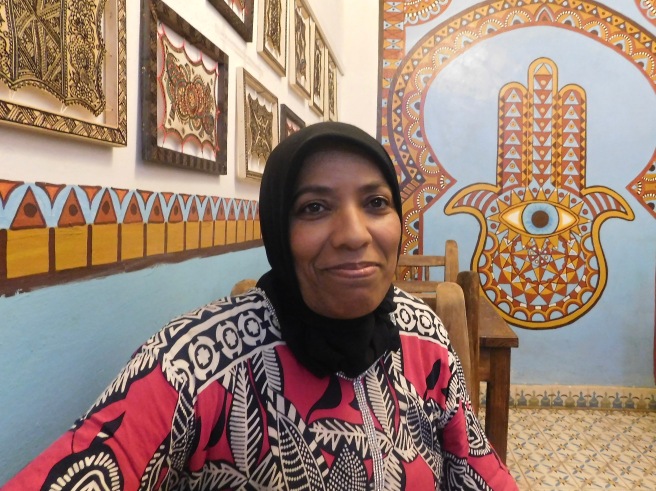
“When I was 12, I started to draw and then started henna by myself with the help of my mother.” says Nadia.
Nadia, pictured above, is a henna artist in Marrakech. She is an Amazigh woman who has worked with henna all her life. Nadia was born in Zagora, near Ouarzazate, Morocco.
The Amazigh are the traditional peoples of Morocco. Amazigh people originate and live in Morocco, Algeria, Tunisia, Libya and western Egypt. Henna is a traditional ritual for Amazigh in Morocco and throughout the other various countries where Amazigh reside.
Henna has been used within Amazigh culture in the mountain regions and around the Saharan regions in Morocco throughout the entirety of their history. In the north, designs are small with much detail compared to in the south which has larger more floral focused designs.
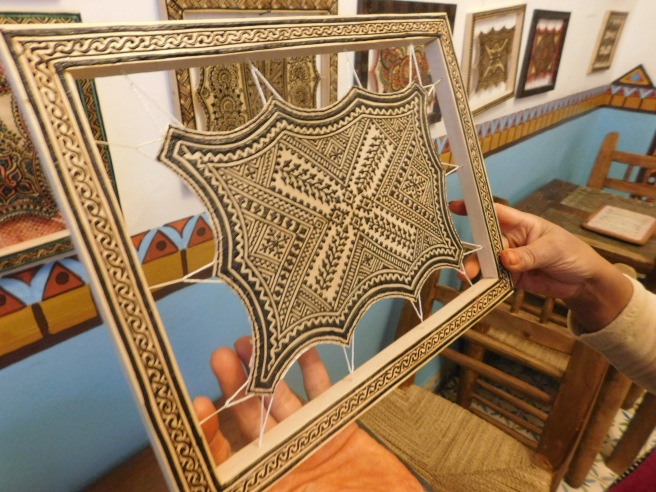 Nadia’s favourite design is the Saharan linear, as pictured above in her work on canvas.
Nadia’s favourite design is the Saharan linear, as pictured above in her work on canvas.
At the Henna Cafe parlour in Marrakech where Nadia works, all women have their own distinct styles of henna. Nadia favours the Saharan design admitting, “it reminds me of home”.
Although different, all of the women’s styles are traditional Amazigh Moroccan designs. They say they are carrying on their Amazigh heritage through henna.
The business model behind henna parlours does not explicitly recognise the cultural practice of the Amazigh. Regardless of whether henna is done by Amazigh or not, lack of recognition and understanding of henna prevents individuals from properly understanding the culture as they may have wished to when deciding to get henna.
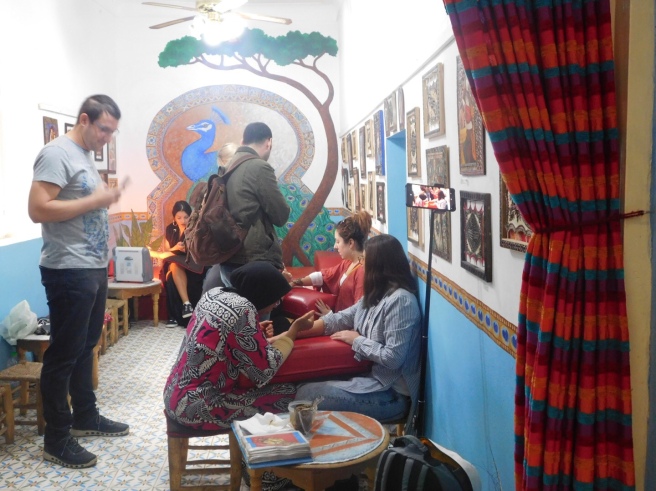 Tourists in a henna parlour.
Tourists in a henna parlour.
The ability to keep Amazigh traditions and cultures alive in Morocco has been tested throughout the entirety of Morocco’s existence. In 1940 the ‘Dahit Al-Barbari’ law was enacted by the French when they were protectorates over Morocco (Khalid Chahhou, 2014).
The law was enacted with the intention to preserve Amazigh customs. Instead, the law worked to create a national divide (Khalid Chahhou, 2014) between the Amazigh and Arabs. The French created Berber schools and Arab schools to be separate in hopes to divide the two.
Amazigh are often referred to as Berbers and were referred to as the later when this law was enacted. The term Berber has negative connotations of that matching ‘barbarians’ for the traditional peoples of the North African region. Amazigh instead has the meaning of ‘free’ in the Amazigh language of Tamazigh.
Prior to French colonialism of Morocco, the Muslim Conquest occurred in Morocco in 647ad. This brought the beginning of Islamisation and Arabisation to Morocco. The Muslim Conquest brought influences such as the rise of Sunni Islam sweeping the country aiding to the now 99% Islam following. In this period there were no issues of the magnitude that there are today with dis-unification amongst Arabs and Amazigh.
The Muslim Conquest also brought a shift in language. Arabic spread through Morocco and is now most commonly spoken alongside French. Tamazigh became a constitutionalised language in 2011 and began being taught in schools in the early 2000s. The Tamazigh language is now also on major road signs and in many public spaces around Morocco.
The historical dis-unification of Amazigh and Arabs has caused large gaps between both cultures, with Amazigh development and socioeconomic growth falling behind that of Arabs in Morocco.
“I was born in a Berber village. When I was 10 we moved to Marrakech for a better life as it was getting hard to live there. My family moved so my brothers and sisters and I could all finish school. We moved here for a better life.” says Rashid, part owner of the Henna Cafe in Marrakech.
“It’s really important to keep the traditional Amazigh designs in the henna.” Rashid says. He believes traditions such as henna are important for keeping the cultures of the Amazigh people alive.
Today the Amazigh are still fighting against various degrees of oppression within Morocco. These oppressions range from denial of recognition for their national holidays, lack of womens rights and lack of legal rights within Morocco. The Amazigh community continues to be marginalised when their culture is not recognised with the continual Arabisation and Islamisation in Morocco.
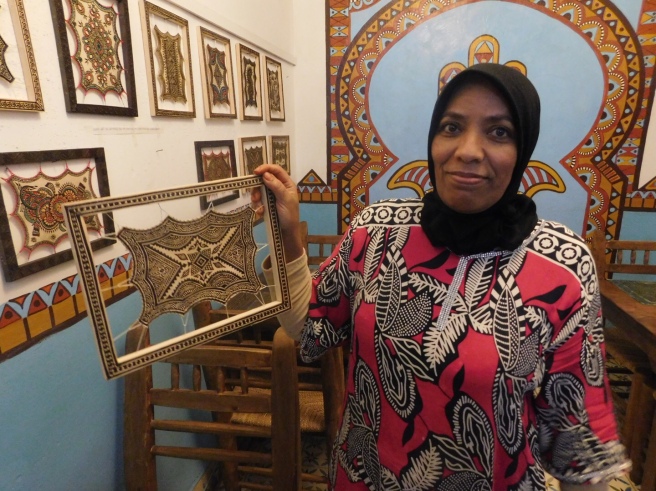 Nadia in the henna studio with her favourite design.
Nadia in the henna studio with her favourite design.
Further reference links:
Chahhou, Khalid, 10-1-2014, “The Status of Languages in Post-Independent Morocco: Moroccan National Policies and Spanish Cultural Action”, City University of New York, Graduate Center, Deakin University E-library PDF, Accessed 1st December 2018
See below links for North African Henna Designs:
Click to access northafrican3.pdf
Click to access northafrican4.pdf
